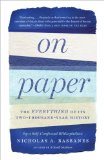Summary | Excerpt | Reviews | Beyond the Book | Readalikes | Genres & Themes | Author Bio

Critics' Opinion:
Readers' Opinion:
First Published:
Oct 2013, 448 pages
Paperback:
Jul 2014, 448 pages
 Book Reviewed by:
Book Reviewed by:
Bob Sauerbrey
Buy This Book
Preface
As a writer of nonfiction, I have devoted a good deal of my life to the study of books in every conceivable context, so a work now on the stuff of transmission itself should come as no surprise to anyone. But in the end, these venerable containers of shared wisdom were merely the launching pad for what became a far wider and much deeper adventure of inquiry, one that still has me turning up stories and ideas that in a world without limits would demand inclusion in these pages—it is that compelling a subject.
Beyond paper's obvious utility as a writing surface, its invention in China during the early years of the modern era made possible the introduction of printing, with the first known devices being stamps made from carved wooden blocks, a process known today as xylography (literally, writing with wood). Not long after the Arab world learned to make paper from the Chinese in the eighth century, the Middle East became a center of intellectual energy, with paper providing the ideal means of recording the thoughts and calculations of Islamic scholars and mathematicians. Making its first toehold in Europe by way of Spain late in the eleventh century, the process moved in the thirteenth to Italy, which became, at about the same time, the cradle of what in later years would be known as the Renaissance. From Europe it made its way to North America and the rest of the inhabited world.
The inexorable spread of this versatile material has been told in bits and pieces by a number of paper specialists whose works are thoroughly referenced in my bibliography. While I am certainly mindful of the chronological sweep of this ubiquitous product, a conventional timeline of its discovery and adoption is not the central thrust of this book, even though one of the goals of Part I is nonetheless to provide a selective overview of its glorious history.
Instead, my driving interest points more to the idea of paper, one that certainly takes in the twin notions of medium and message but that also examines its indispensability as a tool of flexibility and function. The laser physicist and master origami folder Robert Lang, whom you will meet in Chapter 15, lives by the credo that "anything is possible in origami," which can pretty much be said about paper itself. Paper is light, absorbent, strong, plentiful, and portable; you can fold it, mail it, coat it with wax and waterproof it, wrap gunpowder or tobacco in it, boil tea in it. We have used paper in abundance to record our history, make our laws, conduct our business, correspond with our loved ones, decorate our walls, and establish our identities.
When it comes to pure utility, modern hygienic practice is unimaginable without paper; when used as currency, people will move heaven and earth to possess it. In realms of the intellect, every manner of scientific inquiry begins as a nonverbal spark in the mind, and more often than not that first burst of perception is visualized more fully on a sheet of paper. When it's used as an instrument of the generative process, innovators of every persuasion can sketch and tinker away on it at will, design buildings and machines on it, compose music and create poetry on it. As a "paper revolution" swept through Europe in the eighteenth century, architects and engineers transformed the manner and the means of the living landscape. The Industrial Revolution in particular is hard to conceive of without its precisely reproduced instruction sheets to guide assembly crews in their various assignments.
The word virtual has become, in the computer age, one way of describing a simulated reality that exists quite apart from the concrete world, an alternative existence that is not just a copy but a substitute for the real thing. In the expression of imagery, there is nothing at all new about the concept; people have endeavored to create likenesses of themselves and their surroundings for millennia, with examples to be found in cave paintings prepared thousands of years ago, during the last ice age, many of them impressive to this day for their artistry and execution. By no means unique in this regard, paper has nonetheless been around for centuries, nobly fulfilling that function
Excerpted from On Paper by Nicholas A. Basbanes. Copyright © 2013 by Nicholas A. Basbanes. Excerpted by permission of Knopf, a division of Random House LLC. All rights reserved. No part of this excerpt may be reproduced or reprinted without permission in writing from the publisher.





The Funeral Cryer by Wenyan Lu
Debut novelist Wenyan Lu brings us this witty yet profound story about one woman's midlife reawakening in contemporary rural China.
Your guide toexceptional books
BookBrowse seeks out and recommends the best in contemporary fiction and nonfiction—books that not only engage and entertain but also deepen our understanding of ourselves and the world around us.